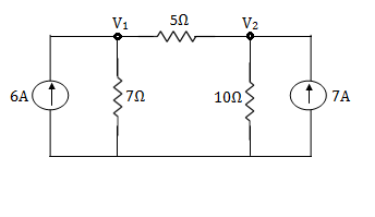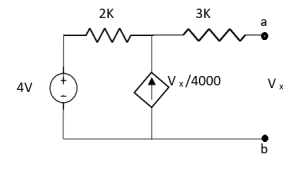UNIT-2
DC Circuits
LOOP ANALYSIS

For Loop 1 with il

For Loop 2 with i2

For Loop 3 with i3

Example 1. For the circuits given below write the voltage equations:

Solution: Let current i1be in loop 1 current and i2 for loop 2




Solution:

For loop 1

For loop 2

NODE ANALYSIS
For these we assume every node as a voltage point and write the current equation for every element. For current source, current entering is negative.

For node V1

For node V2

For V

Example: Using nodal analysis find voltage across 5resistor.

Solution:

For V1


 1
1
For V2


 2
2
Solving 1 and 2:


For 5 voltage = 
= -50.9 + 57.27
= 6.37V
SUPERPOSITION THEOREM
- This is only applicable to circuits with linear elements.
- If two or more than two independent sources (voltage or current) are operating in the circuit than voltage across any element or current through any element is sum of current and voltages due to individual sources.
Question 1. Find the current through  resistance.
resistance.

Solution:

 1 = 0
1 = 0

 2 =
2 =
 1 +
1 +  2
2 
Special Case:

Since two voltage sources with different magnitude in parallel which cannot be connected as in single branch two different current is not possible (if 5V than I = zero).
Question:



 1 =
1 = 
 2 =
2 = 
=
 1 +
1 +  2
2
= 
THEVENIN’S AND NORTON’S THEOREM

Thevenin’s equivalent of A

Norton’s equivalent of A

 sc = Vth/Rth
sc = Vth/Rth
- Norton’s equivalent is obtained by source conversion of thevenin’s equivalent circuit.
CONDITIONS FOR APPLICATION
- For network A:
- Network A should contain linear elements.
- Network A can have independent and dependent current and voltage source.
- If network A has dependent source than controlling parameter must lie in network A itself.
- Network A should not have any source coupling and magnetic coupling.
- For network B:
- It can have linear and non-linear elements.
- It can have dependent and independent voltage and current sources.
- It should not have any source and magnetic coupling with network A.
Method for finding Rth :
Firstly, open circuit terminal A and B.
- If network is operating with only independent sources:
- Make all sources zero in network A.
- Find out the equivalent resistance across terminal A and B.
2. If network A is operating with independent and dependent sources:
- Make all independent sources zero in network A.
- Connect a generation between A and B.
3. If network is operating with only dependent sources:
Connect generation between A and B

Method for Vth:
First open circuit terminal A and B.
Find out the voltage between A and B this is Vth

Method for Isc:
- Isc =

- Remove network B and S.C. The terminal A and B and current from terminal A to B Isc.

Question:

Answer:







Finding Isc from circuit directly:

By KCL,




Question:
Answer


Also, clear from circuit that Vth = 1V.

By applying KVL we get,
1-3Isc=0
Isc= A
A
Que:

Ans;

Rth=3k+2k=5k
By applying KVL we get





Therefore, 
Question:

Solution: For Rth

By KCL,



But, 








By KVL,




Question:

Solution: Since, no independent source is present so,
Isc = 0
And we know that,


Since Rth cannot be zero




But 


Question: Find out the Norton’s equivalent

Solution:



Since, there is no significance of current source






MAXIMUM POWER TRANSFER THEOREM


Where Rth is Thevenin’s equivalent resistance across a and b.

Maximum power is absorbed by ZL when
Condition: 


Comparing real and imaginary parts


OR


Maximum power absorbed by ZL is









Question: Find out the value of load resistance if power absorbed is maximum.

Solution: find Thevenin’s equation






Question: Find maximum power delivered is RL if its value is

- 16Ω
 Ω
Ω- 60Ω
- 20Ω
Solution









Therefore, 